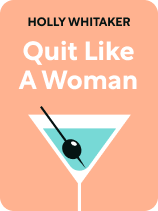

This article is an excerpt from the Shortform book guide to "Quit Like a Woman" by Holly Whitaker. Shortform has the world's best summaries and analyses of books you should be reading.
Like this article? Sign up for a free trial here.
What is Holly Whitaker’s Quit Like a Woman about? What are the main takeaways of the book?
In Quit Like a Woman, Whitaker contends that we as a society see alcohol, addiction, and recovery all wrong—that is, exclusively through a masculine, patriarchal lens. This means we misunderstand what addiction is, what causes it, and how to treat it, especially for women.
Read below for a brief overview of Holly Whitaker’s book Quit Like a Woman.
Quit Like a Woman by Holly Whitaker
Holly Whitaker’s Quit Like a Woman takes on society’s relationship with drinking and recovery. She argues that alcohol is always bad for our bodies but that alcohol companies have persuaded us that drinking is a normal part of adult life and that the only people who shouldn’t drink are fully-fledged alcoholics who exhibit extremely destructive behavior. Because we’re fed these lies, we normalize drinking poison and don’t question our drinking habits, even if they make us unhappy. For those who want to overcome an addiction to alcohol—or any other substance—Whitaker offers a holistic recovery process revolving around healing your inner wounds.
Part 1: Whitaker’s Journey Through Alcoholism
Whitaker recounts her recovery journey, from her denial of her addiction to acceptance of her addiction, and finally, her attempts to quit.
Whitaker’s Denial of Her Alcoholism
Whitaker started drinking at age 13 and continued drinking throughout high school, which led to bad grades, a reputation as being sexually promiscuous, and low self-esteem. In college, she got her life back on track, but when she later started moving up the corporate ladder at a healthcare startup, her drinking, drug use, eating disorder, and spending spiraled out of control.
Whitaker’s Recognition of Her Alcoholism
However, over time, Whitaker began to despise her high-pressure, drink-heavy lifestyle and tried to get herself on track by meditating, eating well, and doing yoga—though, notably, not by giving up drinking. Then, one morning, she woke up hungover in her filthy apartment on a stained mattress without sheets and realized she couldn’t do this anymore. She realized the first step toward building a lifestyle she wanted was to stop drinking.
Whitaker’s Quitting Alcohol
Whitaker quit drinking twice before doing so successfully. The first time, she quit because she became convinced she had Borderline Personality Disorder. This, to her, explained her struggle with alcohol and was a good reason to stop drinking. She stayed sober for eight weeks before drinking again. This started a period of binging and vacillating between drinking and being sober. She went sober again for two weeks and finally went fully sober on April 14, 2013.
Part 2: Truths and Lies About Alcohol and Recovery Programs
Why did Whitaker struggle for so long to recognize her alcoholism? She claims it’s because we’re conditioned to believe drinking is normal and enjoyable and only a problem for people with an inborn weakness showing obvious and extreme symptoms of alcohol addiction.
Part 3: The Real Cause of Alcoholism: Inner Wounds
Now that we’ve covered the lies about alcohol and alcoholism, let’s look at what Whitaker feels to be a more common cause of alcoholism than the generally assumed genetic basis for addictive behavior. While some people do have a biological predisposition to addiction, addiction is also a symptom of inner suffering that can arise in response to the challenges of existing in a patriarchal, capitalist society.
Whitaker explains that when you’ve suffered trauma, had a difficult upbringing, are societally oppressed or marginalized, have mental health issues, don’t have a strong support network, or suffer from other inner pain, you’re more likely to turn to outside sources—drugs, alcohol, shopping, and so on—for the comfort and validation you can’t give yourself. For instance, you might eat excessively to make yourself feel better about a bad test grade you know your parents will punish you for, or you might drink to numb the pain of a workplace microaggression.
When you repeatedly use an outside substance to cope with inner pain, you reinforce a neurological cycle of addiction to that substance, continues Whitaker: Outside sources of pleasure trigger the release of dopamine, the happiness hormone. Then, the substance triggers the subsequent release of glutamate, which makes you remember how happy the addictive substance made you feel so you’ll want to take it again. When this cycle repeats for long enough, you come to believe the pleasurable substance is not only enjoyable but necessary for survival, and you prioritize it over true survival needs, like finding nourishment, procreating, and defending yourself. You thus become addicted, concludes Whitaker.
Part 4: The Five Facets of Whitaker’s Approach to Recovery
Whitaker breaks her recovery approach into five facets, which we’ll explore below. She stresses that this type of recovery isn’t linear and goal-oriented, like AA. Rather, it’s a journey and as much about discovering yourself as getting sober. Further, your journey will be unique to you, and you must explore and move along it in the best way for you.
Facet #1: Be Kind to Yourself
Whitaker argues that one of the most important facets of your recovery journey is to learn to be kind to yourself to heal your inner wounds. Only when you’re gentle and forgiving with yourself, rather than severe and punitive, will you be able to stop suffering permanently.
Facet #2: Form New, Good Habits to Replace Old, Bad Habits
The second facet of recovering is to create positive habits that make you think less about whether to engage in an addictive habit, writes Whitaker. When you automate healthy processes in your daily life that replace old, addictive processes, you reduce the amount of conscious thought you put into them and give yourself less opportunity to even consider engaging in the addictive behavior.
For instance, if you’re trying to overcome fast food addiction and normally stop by McDonald’s to soothe yourself with food after work, you might form the new habit of stopping by a park on the way home and sitting in the sun. Once you’ve solidified this habit, you won’t have to work so hard to resist McDonald’s because your decision to go to the park will be almost automatic.
Facet #3: Set Up a Sustainable, Self-Protective Lifestyle
The next facet of Whitaker’s recovery strategy is to set up a long-term lifestyle that makes you happy, maintains your mental health, and protects you from people and things that could trigger addictive behaviors.
Facet #4: Deal Effectively With Other People
The fourth facet of your recovery journey is learning how to deal effectively with others, writes Whitaker. Navigating relationships as a newly sober person can be difficult because many of them will change now that you’re no longer drinking.
Facet #5: Harness Recovery as a Social Justice Tool
Finally, as you progress through your recovery journey, the new ways you see the world and the critical eye you bring to existing systems (the alcohol industry and our collective belief in the goodness of alcohol, for example) might attune you to broader injustices in the world. As you open your eyes to iniquity and oppression, consider using that knowledge to help catalyze change.

———End of Preview———
Like what you just read? Read the rest of the world's best book summary and analysis of Holly Whitaker's "Quit Like a Woman" at Shortform.
Here's what you'll find in our full Quit Like a Woman summary:
- Why society misunderstands what alcohol addiction is, what causes it, and how to treat it
- Why alcohol is always bad for you, even in moderation
- A feminine, holistic approach to recovery and sobriety






